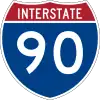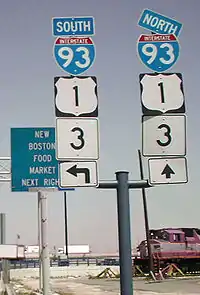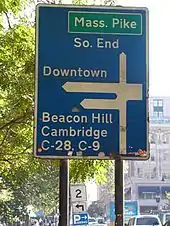Massachusetts State Highway System
The Massachusetts State Highway System in the U.S. Commonwealth of Massachusetts is a system of state-numbered routes assigned and marked by the highway division of the Massachusetts Department of Transportation (MassDOT). U.S. Highways and Interstate Highways are included in the system; the only overlaps are with the end-to-end U.S. Route 3 and Route 3 and the far-apart Interstate 295, shared with Rhode Island, and Route 295, shared with New York State. A state highway in Massachusetts is a road maintained by the state, which may or may not have a number. Not all numbered routes are maintained or owned by the state.
| Massachusetts State Highway System | |
|---|---|
   Highway markers for Interstate 90, U.S. Route 20 and Route 28 | |
| System information | |
| Notes | Routes are not always state-maintained, and not all state highways are Routes. |
| Highway names | |
| Interstates | Route I-X or Route X |
| US Highways | Route US X or Route X |
| State | Route X |
| System links | |
History
The Massachusetts Highway Commission (MHC) was the first highway commission in the U.S., formed in 1893 in response to a commission of inquiry finding that over 90% of the public roads in the state were in poor condition.[1][2] The first state highway in Massachusetts was a 5305.17-foot (1617.02 m) section of Fitchburg Road (now Main Street, part of Route 119) in Ashby. The MHC laid it out as a state highway on August 15, 1894 from a point west of South Road to a point west of Route 31. The road was paved with 15–20 foot (4.5–6 m) macadam, with work beginning August 21, 1894 and ending July 15, 1895. The 50–66 foot (15–20 m) right-of-way is still owned by MassDOT under the original layout.[3][4]
Massachusetts first gained numbered routes in 1922, with the formation of the New England Interstate Highways. Three-digit numbers were reserved for shorter routes. Route 138 and Route 140 were designated by 1925, and by 1926 the numbers from Route 101 to Route 142 (except Route 136) had been assigned.
The establishment of the U.S. Highway System in 1926 resulted in several of the New England Interstate routes having to be renumbered. The New England Interstate routes that conflicted with new U.S. Highway numbers were assigned newly freed single-digit numbers. Beginning in 1929, local routes were assigned new two-digit numbers. With the exception of Route 143, which was renumbered from Route 109A ca. 1933, new routes were given two-digit numbers for a while. Larger three-digit numbers were eventually assigned.
Over the years, most of the state's highways have been maintained by a varied list of agencies, including the Massachusetts Highway Department, Massachusetts Turnpike Authority, and the Massachusetts Port Authority, but are now maintained by the consolidated MassDOT. The Massachusetts Department of Conservation and Recreation's Bureau of Engineering still manages and/or operates a number of parkways across the Commonwealth.
All routes that end at a state border and continue as a numbered route on the other side have been renumbered on one side of the border to match. Except for Route 295, far from Interstate 295, numbers that were duplicated with Interstate Highways were renumbered, mostly in 1959 when the Interstate numbers were assigned.
- The longest numbered highway in the state is U.S. Route 20, which runs for 153 miles (246 km).
- The longest state highway is Route 28, which runs for 151.92 miles (244.49 km).
- The longest Interstate highway in Massachusetts is Interstate 90 (the Mass Pike), which runs 138.1 miles (222.3 km).
- The shortest route in Massachusetts is Route 15, which runs for only 0.23 miles (0.37 km). The shortest signed highway is Route 108, which runs for 0.92-mile (1.48 km). Both are short extensions of state highways in neighboring states. The shortest route completely within state borders is Route 240, which runs for 1-mile (1.6 km).
- The shortest Interstate in Massachusetts is Interstate 295, which runs as a 4-mile (6.4 km) extension of I-295 in Rhode Island.
There are no state or federal highways of any kind in the island counties, Nantucket or Dukes. There are eight mainland towns which have no state or federal highway routes: Mount Washington and Tyringham in Berkshire County, Hampden in Hampden County, Middlefield in Hampshire County, Leyden, Monroe and Rowe in Franklin County, and Nahant in Essex County. Other than Nahant, which is a peninsula town just south of the city of Lynn, the towns are mostly isolated rural communities in the western half of the state. Additionally, there are seven other towns which do not have any Massachusetts state highways: Chester, Holland, Mattapoisett, Montgomery, New Ashford, Shutesbury and Wilbraham. Wellfleet does not have any signed state highways but includes the silent concurrency of Route 6A with U.S. Route 6. Several other towns have less than a mile of state highway.
Signage practices

State routes
Massachusetts uses a simple design for its state route shields. Black numerals are displayed on a plain white shield, usually with a black border near the edge of the sign, although this differs from sign to sign, especially on highway overheads. Single- and double-digit state highway numbers are posted on standard square sign panels, while three-digit (and three- and four-character alternate such as 28A) numbers are displayed on elongated panels. State route shields on freeways, such as Route 24 and Route 128 have the same design, but are usually much larger in size for easier viewing at highway speeds.
U.S. Routes
Massachusetts uses the standard white-shield on black background design for its U.S. Routes, used in all states except for California. Signs for U.S. Routes on green highway signs generally omit the black background, but some older signs still have them. A number of signs installed on the U.S. Route 3 expressway are of a cut-out design, without the black background. U.S. Routes on freeways usually have extra-large sign panels posted.
NOTE: Alternates of U.S. routes in Massachusetts are signed as state highways (Routes 1A, 3A (northern), 6A, 7A, and 20A).
Interstate Highways
Massachusetts uses standard Interstate highway shields without the state name on the shield, although a small number of very old signs do exist with the state name. Interstate shields are usually of the extra-large variety, with the exception of the Massachusetts Turnpike (Interstate 90), which uses standard shields.
Auxiliary routes

Massachusetts does not use auxiliary tabs for route signage, and as such contains no bypass or business routes. Massachusetts formerly had "city routes", which were signed C1, C9, C28, and C37, as city alignments of the respective state routes. All of these designations were decommissioned in the early 1970s. Since then, no route in Massachusetts has ever had more than one alternate, save for multiple sections of a single numbered route such as 1A, 2A or 3A. (a Route 3B existed in the 1920s but was renumbered to Route 38).
The Lowell Connector was technically the only "auxiliary" route in the state, having been formerly signed as Interstate 495 Business Spur in the 1960s.
Exit numbering
Massachusetts is one of the few U.S. states that still uses sequential exit numbering on its freeways. The state amendments to the 2009 national MUTCD, published in January 2012, stated that Massachusetts would be changing all exit numbers to the mileage-based system "within the next five to ten years".[5] This change was supposed to be made starting in 2016 when a project to renumber all currently numbered exits to those based on highway mileposts was to start.[6] This project, though, was indefinitely postponed in the middle of 2016 until on November 18, 2019 the MassDot confirmed that beginning in late summer 2020 the exit renumbering project will begin.[7] Exit numbers are posted on all of its Interstate Highways, as well as other major freeways in the state, including the freeway portions of Route 2, the Pilgrims Highway (part of Route 3), the Northwest Expressway (part of US 3), Route 24, Route 25, Route 128, the southern portion of Route 140, Route 213, and most recently, Route 146.
Five freeways in Massachusetts contain irregular exit numbering patterns:
- On Route 2, exit numbers start at 14 and increase to 43, with a gap in the freeway between Acton and Lexington. Exit numbering resumes at 52 and ends at 60.
- The Northwest Expressway (US 3) is the one freeway in Massachusetts that still uses the "25 is 128" system. As such, its exit numbering scheme starts at 25 (at Route 128/I-95) and goes up to 36.
- Route 128 has reversed exit numbering; that is, exit numbers increase going north-to-south. Exit numbers start at 29 and end at 10. There are no exits 1-9, there is no exit 11, and exit 27 was removed. Route 128 has always had this system; however most of its exit numbering was replaced by the standard south-to-north of I-93 and I-95 south of Peabody.
- I-93 in Boston has gone under many exit numbering changes since the Big Dig project was completed, and many old interchanges were closed or reconfigured. Numbering on the Interstate goes from 1 to 48, but the following exit numbers no longer exist: 17, 19, 21, 22, and 25.
- Numbering on the Massachusetts Turnpike (I-90) increases from 1 to 26; however, exits 11 and 11A are almost 10 miles apart, exits 14 and 15 are the same exit, exit 15B is a westbound only off ramp, exits 18 and 20 are the same exit, exit 19 was a mainline toll plaza until 2016, and exits 21 and 23 are westbound on-ramps only.
Signage errors

Massachusetts is rather notorious for the placement of incorrect signage along its numbered highways. Some older, erroneous signs for state routes show numbers in a white circle rather than rounded square, with black on the outside; although not codified, a number of examples of this design remain extant. Some of these errors are due to outdated signage which have not been replaced since a realignment or truncation of a route, which can lead to confusion as to where a particular route goes. Lack of route signage in urban areas is a common problem.
One very common signage error, which occurs in many states, is the mis-signage of a U.S. Highway as a state route (mostly on guide signs). This occurs in many places along U.S. Route 202, as well as on sections of U.S. Route 20 and in a few spots along U.S. Route 1, U.S. Route 6 and U.S. Route 44. These are less confusing sign errors, as U.S. Routes are part of the Massachusetts State Highway System, and thus do not share numbers with other state routes (the one exception being U.S./MA Route 3, which connect end-to-end and are treated as the same route by the state). Near Route 126 in Bellingham, Elm Street has a US 126 sign.
A more unusual signage error occurred at the intersection of Route 10 and Route 141 in Easthampton in July 2005, in which Alabama state route markers were installed for the two routes. This error came from a contractor who mistakenly signed the route based on the design in the Manual on Uniform Traffic Control Devices that showed an Alabama route marker.[8][9]
References
- Massachusetts Registry of Motor Vehicles, History of the Massachusetts License Plate. "Archived copy". Archived from the original on June 6, 2011. Retrieved March 22, 2019.CS1 maint: archived copy as title (link) CS1 maint: bot: original URL status unknown (link).
- "Journey by Land: Automobiles & Highways". Pilgrim Hall Museum. May 18, 2005. Archived from the original on February 4, 2012.
- MassDOT state highway layout plan 1 (August 15, 1894). "Archived copy". Archived from the original on February 16, 2012. Retrieved March 22, 2019.CS1 maint: archived copy as title (link) CS1 maint: bot: original URL status unknown (link).
- MassDOT state highway layout plans: About page. "Archived copy". Archived from the original on July 8, 2014. Retrieved March 5, 2015.CS1 maint: archived copy as title (link).
- Highway Division (2012). "Section 2E.31: Interchange Exit Numbering". The Massachusetts Amendments to the 2009 Manual on Uniform Traffic Control Devices and the Standard Municipal Traffic Code (PDF). Massachusetts Department of Transportation. p. 62. Retrieved August 7, 2013.
- "Exit Signage Conversion to Milepost-Based Numbering System along Various Interstates, Routes and the Lowell Connector". Massachusetts Department of Transportation. September 12, 2015. Retrieved September 14, 2015.
- Malme, Robert H. (February 9, 2017). "Interstate Exits in Massachusetts". Retrieved March 3, 2017.
- Daniel, Mac (July 26, 2005). "Word to road crews: Tuscaloosa is over 1,000 miles thataway". The Boston Globe. Retrieved December 31, 2009.
- "Alabama road signs in Massachusetts?". WSFA-TV. Archived from the original on March 3, 2016.
External links
- Highway Division of the Massachusetts Department of Transportation
- Maps, Data, and Reports by the Massachusetts Department of Transportation, Office of Transportation Planning
- nehwys.com Massachusetts Route Log
- The Roads of Massachusetts
- Road Signs of Massachusetts
- Current and Speculative Massachusetts Interstates Future Exit Number Lists